Kubernetes for the Absolute Beginners - Hands-on Tutorial
Kubernetes on the Cloud
Kubernetes on GCP GKE
In this article, you will learn how to deploy your application on Google Kubernetes Engine (GKE) within the Google Cloud Platform (GCP). Before getting started, ensure you have access to a Google Cloud account. Google offers a 12-month free trial with a $300 credit, which is sufficient for following along with this guide.

A basic understanding of the GCP console and shell usage is essential, as you will configure the prerequisites directly in the cloud console.
Pre-requisites
Ensure you have:
- A valid Google Cloud account.
- Familiarity with GCP Console and basic terminal commands.
Creating the Cluster
After logging into the GCP console, locate your project. In this example, we will use the project named "Example Voting App". Follow these steps to begin configuring GKE:
- Click the navigation menu at the top left corner.
- Under the Compute section, select Kubernetes Engine.
- In the Kubernetes Engine section, click Create Cluster.
This action opens the Kubernetes cluster creation interface:
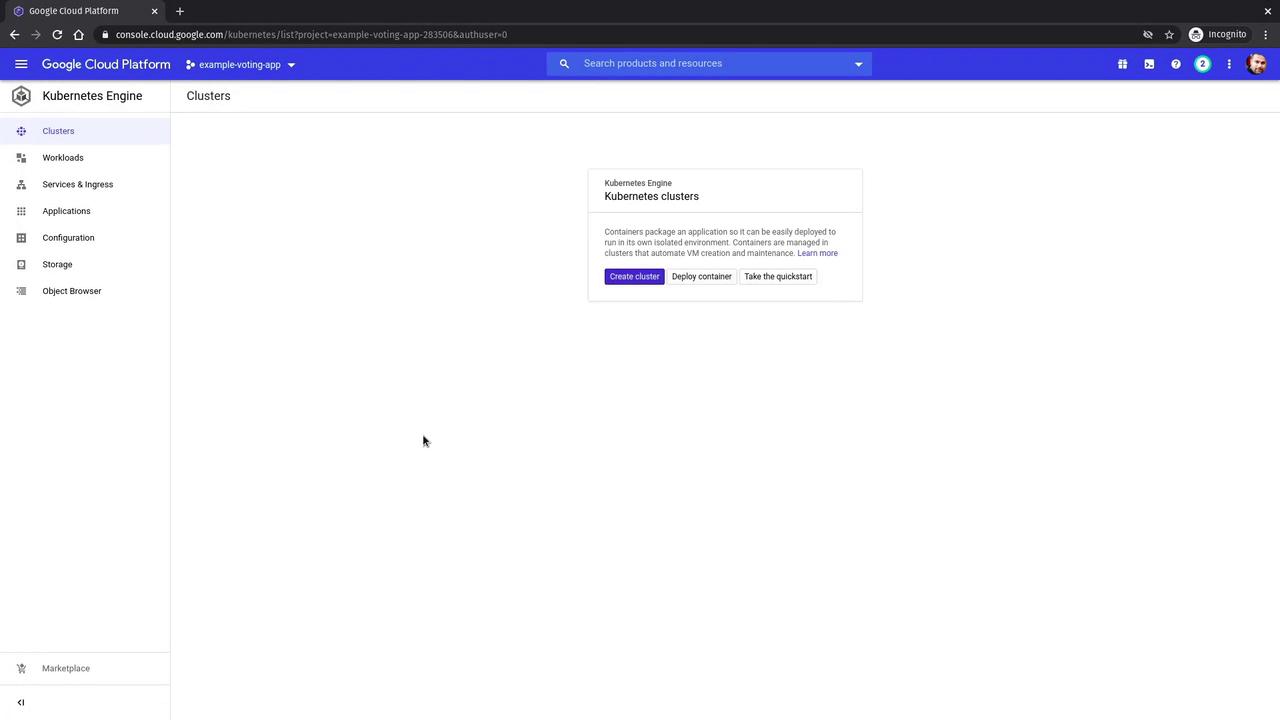
Cluster Settings
- Rename the cluster to "Example Voting App".
- Use the default values for location type and zone.
- For the master version, you can either select a static version or a release channel for automatic upgrades. For this demonstration, leave it at the default setting.
Additional options are available for worker nodes, such as configuring the VM type or size; however, the default settings will suffice for this tutorial.
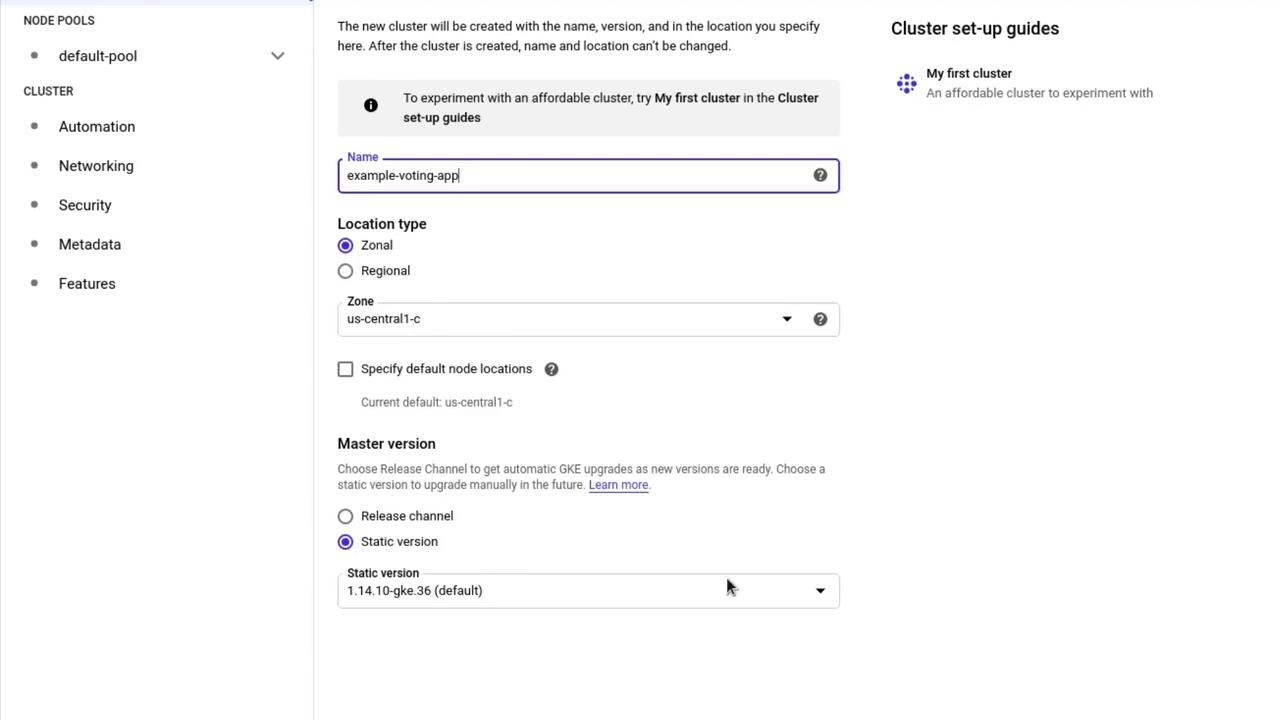
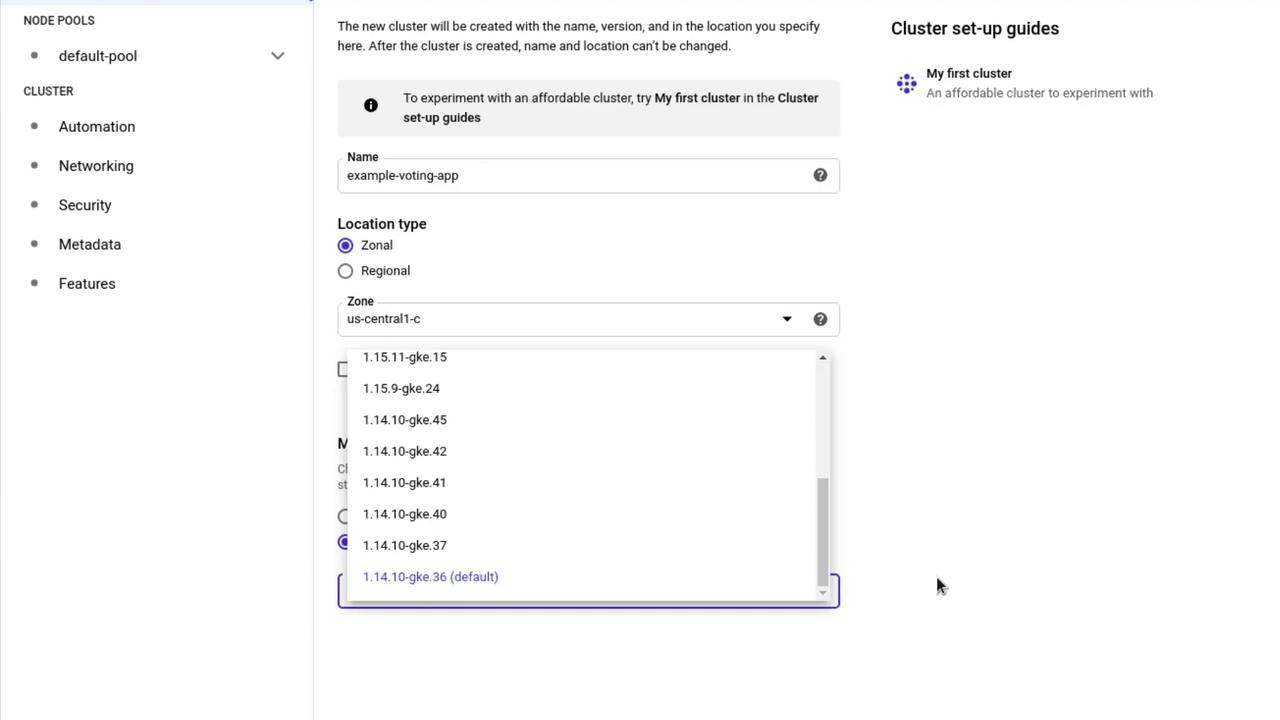
Once your configuration is complete, click Create to begin provision the cluster. Note that this process typically takes between 5 to 10 minutes. You can monitor the progress by clicking the Refresh button:

When the cluster setup is complete, you'll see a green check mark next to the cluster name.
Connecting to Your Cluster
The simplest method to connect to your cluster is by clicking the Connect button:
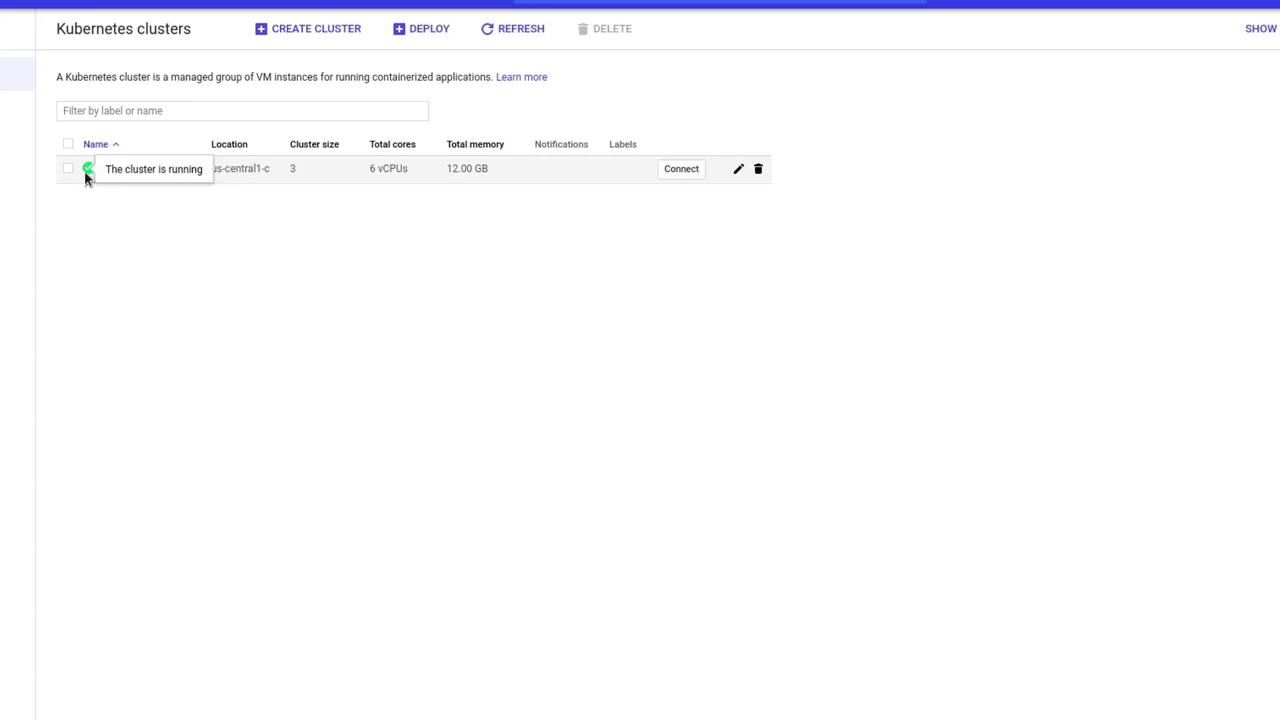
Click Connect to display the command needed to configure kubectl using Cloud Shell. Once the Cloud Shell opens (you can maximize the window for convenience), run the provided command:
gcloud container clusters get-credentials example-voting-app --zone us-central1-c --project example-voting-app-283506
This command updates your kubectl configuration, allowing you to interact with your GKE cluster. To verify the connection, run:
kubectl get nodes
The output should look similar to this:
NAME STATUS ROLES AGE VERSION
gke-example-voting-app-default-pool-e388a8c8-46b0 Ready <none> 86s v1.14.10-gke.36
gke-example-voting-app-default-pool-e388a8c8-bjx4 Ready <none> 95s v1.14.10-gke.36
gke-example-voting-app-default-pool-e388a8c8-rp73 Ready <none> 94s v1.14.10-gke.36
Deploying the Application
Now that your cluster is connected, you can deploy the YAML files for the various Deployments and Services that make up the voting application. These files are available in a GitHub repository. Follow the steps below in your Cloud Shell:
Step 1. Clone the Repository
Execute the following commands to clone the repository and navigate into the project directory:
git clone <repository-url>
cd example-voting-app
Step 2. Navigate to the Kubernetes Specifications Directory
Change into the directory containing the deployment and service definitions:
cd k8s-specifications
ls
You should see files similar to:
postgres-deploy.yaml redis-deploy.yaml result-app-deploy.yaml voting-app-deploy.yaml worker-app-deploy.yaml
postgres-service.yaml redis-service.yaml result-app-service.yaml voting-app-service.yaml
Updating Service Definitions
To ensure the application works seamlessly in a cloud environment, a minor modification was made to the service definitions. For example, the voting service YAML now uses a LoadBalancer instead of a NodePort:
apiVersion: v1
kind: Service
metadata:
name: voting-service
labels:
name: voting-service
app: demo-voting-app
spec:
type: LoadBalancer
ports:
- port: 80
targetPort: 80
selector:
name: voting-app-pod
app: demo-voting-app
A similar update applies to the result app service.
Creating Kubernetes Objects
Create the Kubernetes objects in the order below to ensure proper dependency management:
- Deploy the voting application and its corresponding service.
- Deploy Redis (both deployment and service).
- Deploy PostgreSQL (both deployment and service).
- Deploy the worker application.
- Deploy the result application and its corresponding service.
You can create each object individually:
kubectl create -f voting-app-deploy.yaml
kubectl create -f voting-app-service.yaml
kubectl create -f redis-deploy.yaml
kubectl create -f redis-service.yaml
kubectl create -f postgres-deploy.yaml
kubectl create -f postgres-service.yaml
kubectl create -f worker-app-deploy.yaml
kubectl create -f result-app-deploy.yaml
kubectl create -f result-app-service.yaml
Alternatively, create all objects at once with:
kubectl create -f .
After executing the creation commands, verify that the deployments and services have been successfully created:
kubectl get deployments,svc
The output should resemble:
NAME READY UP-TO-DATE AVAILABLE AGE
deployment.extensions/postgres-deploy 1/1 1 1 34s
deployment.extensions/redis-deploy 1/1 1 1 43s
deployment.extensions/result-app-deploy 1/1 1 1 20s
deployment.extensions/voting-app-deploy 1/1 1 1 52s
deployment.extensions/worker-app-deploy 0/1 1 0 26s
NAME TYPE CLUSTER-IP EXTERNAL-IP PORT(S) AGE
service/db ClusterIP 10.71.3.164 <none> 5432/TCP 30s
service/kubernetes ClusterIP 10.71.0.1 <none> 443/TCP 5m58s
service/redis ClusterIP 10.71.2.124 <none> 6379/TCP 39s
service/result-service LoadBalancer 10.71.3.179 <pending> 80:30764/TCP 13s
service/voting-service LoadBalancer 10.71.0.147 <pending> 80:31036/TCP 48s
Load Balancer Provisioning
Note that the external IP for load balancers might initially show as <pending>. Wait a few minutes and rerun the command to confirm that the IPs have been assigned.
Verifying Load Balancer Configuration
Once all deployments are ready and pods are running, verify the load balancer settings in the GCP console. Navigate to Services & Ingress under the Kubernetes Engine section. Here, you'll see internal services (such as PostgreSQL and Redis) and front-end services that utilize the cloud provider’s native load balancer.
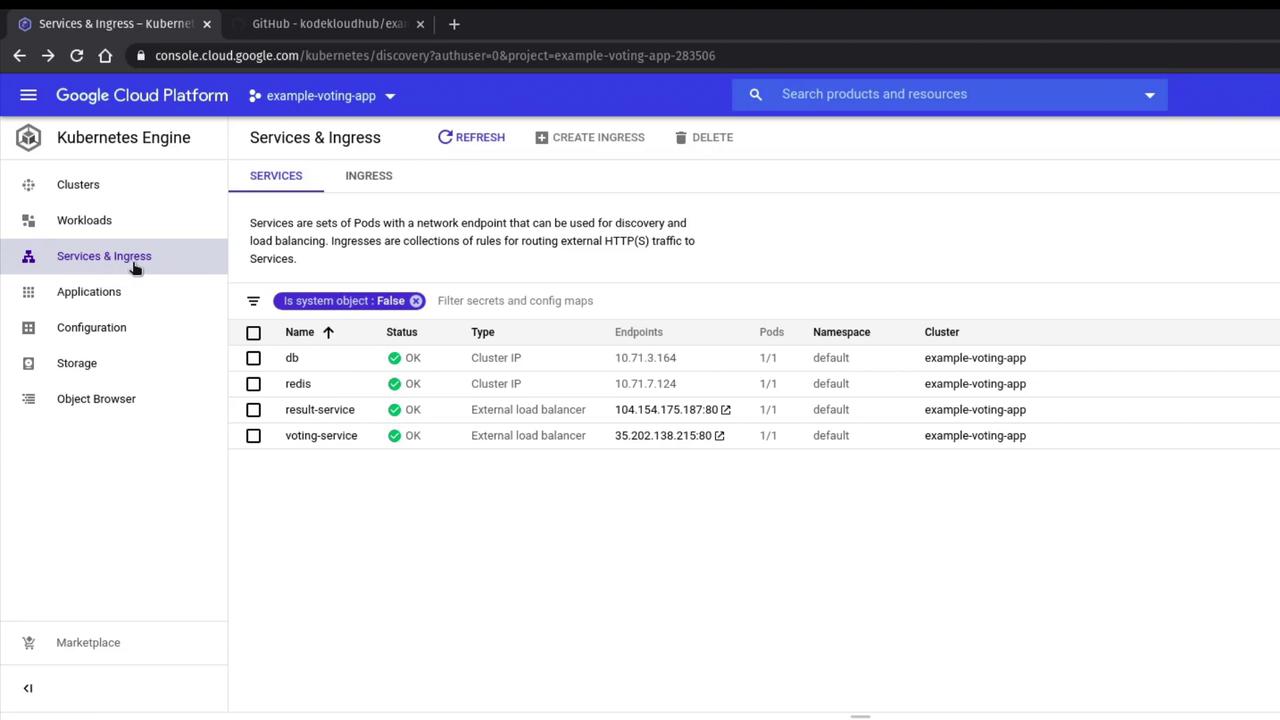
Click on each service to view detailed information including ClusterIP, load balancer IP, and URL endpoints. Ensure that all statuses are marked as OK.
Testing the Application
After the load balancers are assigned external IPs, open a new browser tab and navigate to the external IP associated with the voting service to load the voting application interface. Open another tab to view the results application.
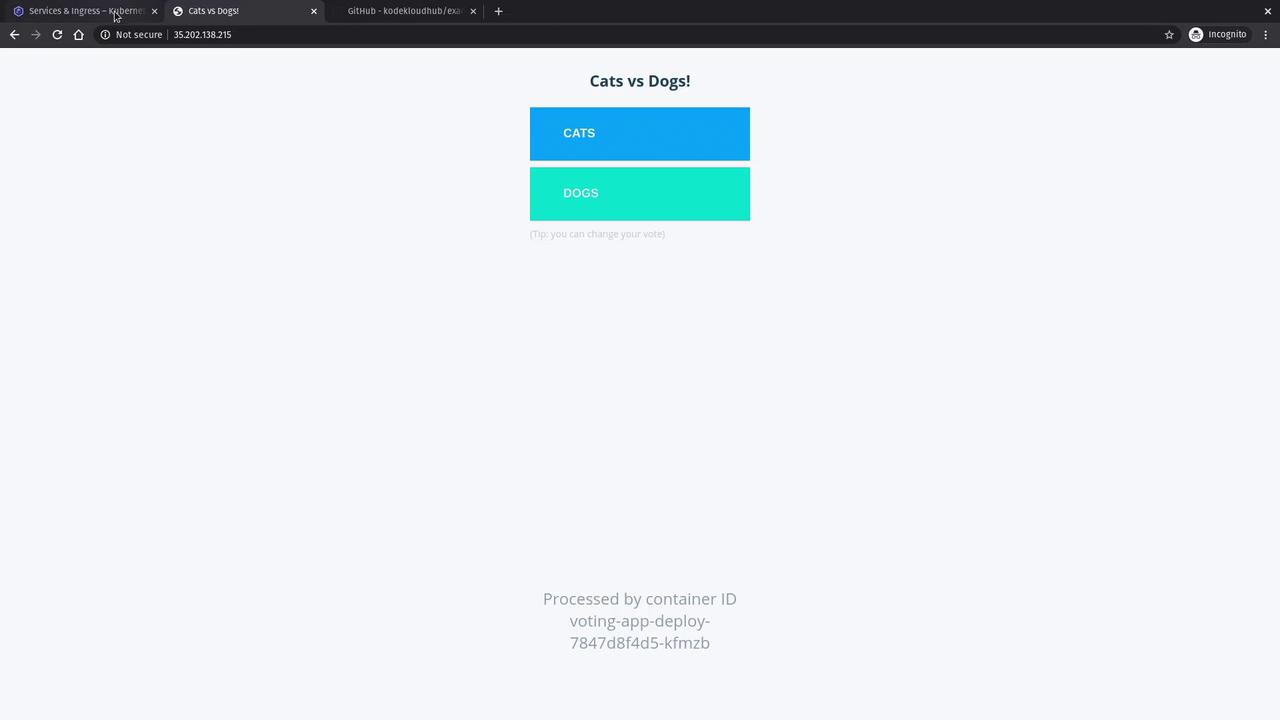
Cast a vote and observe that the results update dynamically to reflect the percentage of votes. Further voting should continuously update the displayed results.
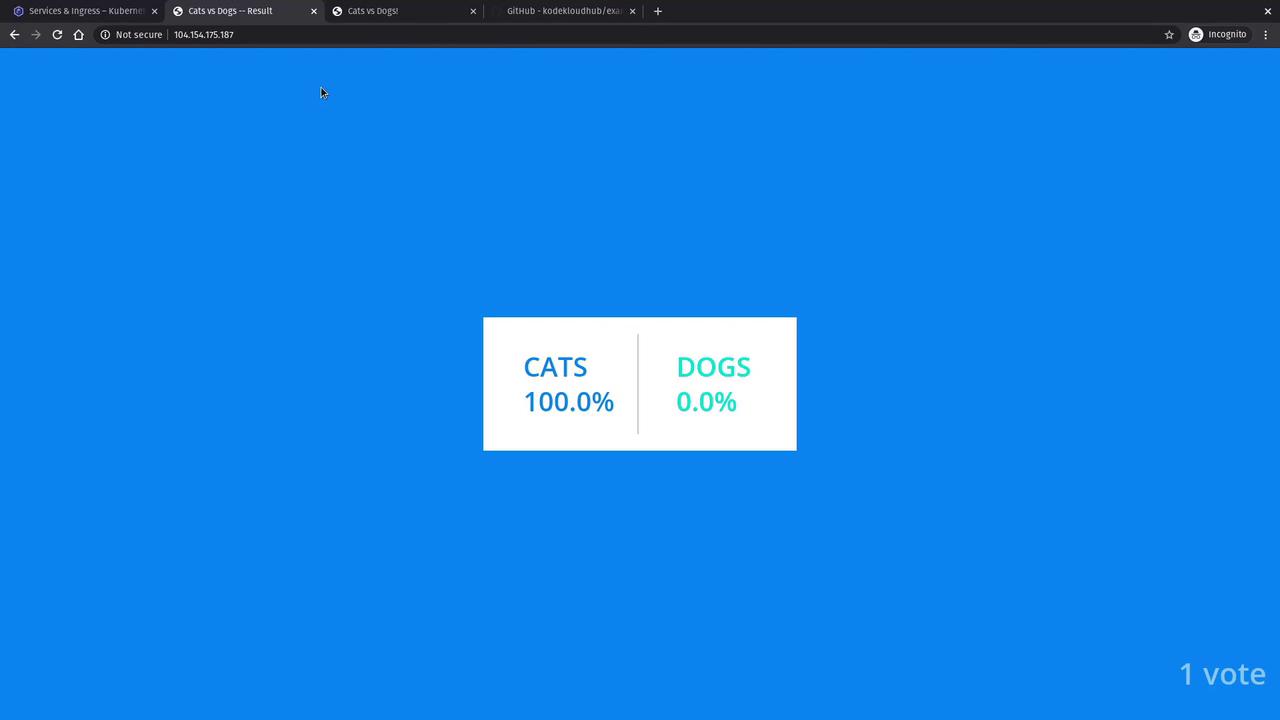
This guide has demonstrated the process of deploying a Kubernetes cluster on GKE and launching a multi-component voting application. Happy deploying, and stay tuned for more advanced Kubernetes tutorials!
Watch Video
Watch video content